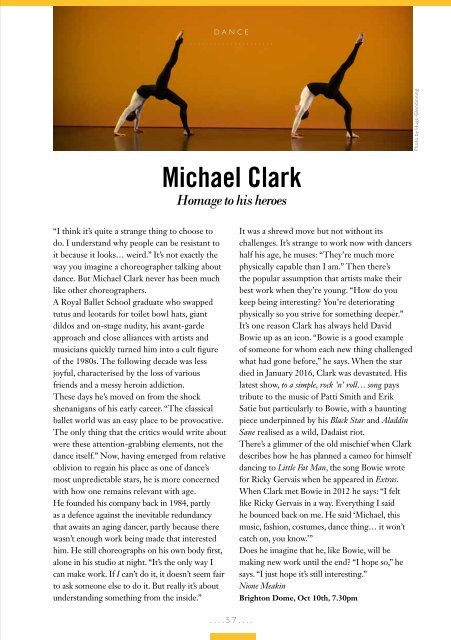Viva Brighton Issue #68 October 2018
You also want an ePaper? Increase the reach of your titles
YUMPU automatically turns print PDFs into web optimized ePapers that Google loves.
DANCE<br />
.....................<br />
Michael Clark<br />
Homage to his heroes<br />
Photo by Hugo Glendinning<br />
“I think it’s quite a strange thing to choose to<br />
do. I understand why people can be resistant to<br />
it because it looks… weird.” It’s not exactly the<br />
way you imagine a choreographer talking about<br />
dance. But Michael Clark never has been much<br />
like other choreographers.<br />
A Royal Ballet School graduate who swapped<br />
tutus and leotards for toilet bowl hats, giant<br />
dildos and on-stage nudity, his avant-garde<br />
approach and close alliances with artists and<br />
musicians quickly turned him into a cult figure<br />
of the 1980s. The following decade was less<br />
joyful, characterised by the loss of various<br />
friends and a messy heroin addiction.<br />
These days he’s moved on from the shock<br />
shenanigans of his early career. “The classical<br />
ballet world was an easy place to be provocative.<br />
The only thing that the critics would write about<br />
were these attention-grabbing elements, not the<br />
dance itself.” Now, having emerged from relative<br />
oblivion to regain his place as one of dance’s<br />
most unpredictable stars, he is more concerned<br />
with how one remains relevant with age.<br />
He founded his company back in 1984, partly<br />
as a defence against the inevitable redundancy<br />
that awaits an aging dancer, partly because there<br />
wasn’t enough work being made that interested<br />
him. He still choreographs on his own body first,<br />
alone in his studio at night. “It’s the only way I<br />
can make work. If I can’t do it, it doesn’t seem fair<br />
to ask someone else to do it. But really it’s about<br />
understanding something from the inside.”<br />
It was a shrewd move but not without its<br />
challenges. It’s strange to work now with dancers<br />
half his age, he muses: “They’re much more<br />
physically capable than I am.” Then there’s<br />
the popular assumption that artists make their<br />
best work when they’re young. “How do you<br />
keep being interesting? You’re deteriorating<br />
physically so you strive for something deeper.”<br />
It’s one reason Clark has always held David<br />
Bowie up as an icon. “Bowie is a good example<br />
of someone for whom each new thing challenged<br />
what had gone before,” he says. When the star<br />
died in January 2016, Clark was devastated. His<br />
latest show, to a simple, rock ’n’ roll… song pays<br />
tribute to the music of Patti Smith and Erik<br />
Satie but particularly to Bowie, with a haunting<br />
piece underpinned by his Black Star and Aladdin<br />
Sane realised as a wild, Dadaist riot.<br />
There’s a glimmer of the old mischief when Clark<br />
describes how he has planned a cameo for himself<br />
dancing to Little Fat Man, the song Bowie wrote<br />
for Ricky Gervais when he appeared in Extras.<br />
When Clark met Bowie in 2012 he says: “I felt<br />
like Ricky Gervais in a way. Everything I said<br />
he bounced back on me. He said ‘Michael, this<br />
music, fashion, costumes, dance thing… it won’t<br />
catch on, you know.’”<br />
Does he imagine that he, like Bowie, will be<br />
making new work until the end? “I hope so,” he<br />
says. “I just hope it’s still interesting.”<br />
Nione Meakin<br />
<strong>Brighton</strong> Dome, Oct 10th, 7.30pm<br />
....57....


















